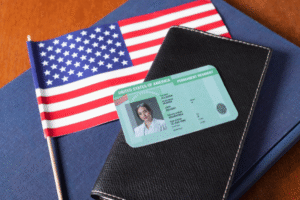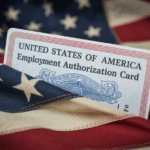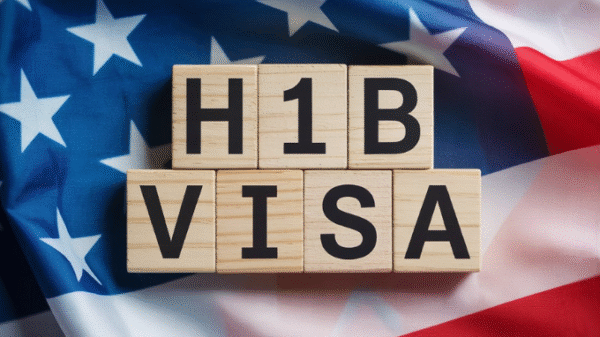The H1B lottery is a random selection process used by the U.S. Citizenship and Immigration Services (USCIS) to choose who can apply for an H1B visa each fiscal year. Because demand far exceeds the annual visa cap, the government introduced this system to manage the volume in a fair and efficient way.
The standard H1B cap is 65,000 visas, with an additional 20,000 reserved for applicants who hold a U.S. master’s degree or higher — known as the master’s cap. In recent years, over 400,000 registrations have been submitted for just 85,000 total spots, making the lottery an unavoidable hurdle for most applicants.
Contrary to popular belief, the H1B lottery isn’t influenced by your skills, salary, or nationality — it’s purely random. However, what matters is what happens after you’re selected: your employer must submit a complete, timely H1B petition that meets all USCIS requirements.
Since 2020, USCIS has used an online registration system that has made the process faster and more accessible, but also led to new problems — like duplicate or fraudulent submissions. In this article, we’ll break down exactly how the lottery works in 2025, what your chances are, and what to do whether you’re selected or not.
What Is the H1B Lottery and Why Does It Exist?
The H1B visa is a nonimmigrant work visa that allows U.S. employers to hire foreign professionals in specialty occupations. But because the number of available H1B visas is capped annually, the demand almost always exceeds supply — and that’s where the lottery comes in.
Each fiscal year, USCIS accepts only 85,000 new H1B petitions:
- 65,000 under the regular cap
- 20,000 under the master’s cap (for U.S. graduate degree holders)
In years past, USCIS would receive more petitions than available slots within the first few days of the filing window. That created massive backlogs and wasted employer resources. To fix this, USCIS introduced the electronic lottery system in 2020, where employers submit basic applicant info during a short registration window. Only those selected in the lottery are allowed to submit the full H1B petition.
The lottery ensures fairness and prevents overloading the system. However, it also means that even qualified applicants aren’t guaranteed a chance to file — making it crucial to understand how it works, how to prepare, and what to do if you’re not selected.
Key Dates for the 2025 H1B Lottery
If you’re planning to enter the H1B lottery for the FY 2025 season, timing is everything. USCIS follows a strict annual cycle, and missing a deadline could mean waiting an entire year to reapply.
Here’s the typical H1B lottery timeline based on USCIS trends from recent years:
March 2025: Lottery Registration Period
- Expected to open: First week of March (e.g., March 1–March 18)
- Employers must submit registrations through the USCIS online portal
- Only a $10 fee per registration is required at this stage
Late March 2025: Selection Results Announced
- USCIS usually conducts the lottery and announces results by March 31
- Employers and attorneys receive notifications in their USCIS accounts
- Selected applicants may proceed with full petition filing
April to June 2025: H1B Petitions Filed
- Selected candidates must submit Form I-129 with supporting documents
- USCIS provides a 90-day filing window (typically from April 1 onward)
- Premium processing may be used to speed up decisions
July–September 2025: Second Round (If Needed)
- If employers don’t file petitions for all selected cases, a second lottery may occur
- In FY2023 and FY2024, USCIS conducted multiple rounds to fill unused slots
Note – These dates may shift slightly each year, so it’s essential to follow USCIS announcements closely or work with an immigration attorney.
Step-by-Step: How H1B Lottery Registration Works
The H1B lottery starts with a simple online registration, which must be completed by your sponsoring employer or their attorney. This system has replaced the old process where full petitions were filed upfront — saving time and money for both USCIS and employers.
Here’s how the registration works for the 2025 season:
Step 1: Employer Creates a USCIS Online Account
Your employer (or their legal representative) must create a “registrant” account on my.uscis.gov. Accounts can typically be created starting mid to late February.
Step 2: Submit Beneficiary Information
For each H1B candidate, the employer enters:
- Full name
- Passport number
- Country of birth
- Degree info
- Master’s cap eligibility (if applicable)
Only basic details are required — no resumes, degrees, or job offer letters at this stage.
Step 3: Pay the $10 Registration Fee
Each beneficiary registration requires a non-refundable $10 fee.
This is paid electronically during submission.
Step 4: Wait for Lottery Results
Once the registration window closes (mid-to-late March), USCIS runs the lottery.
Employers will see one of the following statuses in their USCIS account:
- “Selected” – the applicant can now file Form I-129
- “Not Selected” – ineligible to file this year
- “Denied” – if duplicate or fraudulent registration detected
The entire registration process is done online, and results are usually announced by the end of March.
What Happens After You’re Selected?
If your H1B registration is selected in the lottery, congratulations — but the work isn’t over yet. Selection only gives you the right to file the full H1B petition; it does not guarantee visa approval.
Here’s what happens next:
1. File Form I-129 (H1B Petition)
Your employer must file Form I-129 with USCIS within the 90-day filing window, usually starting April 1.
This petition includes:
- Detailed job offer and job description
- Proof of your qualifications (degrees, experience letters)
- Employer’s financial and tax documents
- Approved LCA (Labor Condition Application) from the U.S. Department of Labor
2. Choose Regular or Premium Processing
- Regular processing takes several months
- Premium processing (for an additional fee) gives a USCIS decision within 15 calendar days
3. File Only One Petition Per Employer
If you were registered by multiple unrelated employers, each one can file a petition — but only one per employer is allowed.
Multiple petitions from related or coordinated companies may be rejected.
4. Visa Stamping or Change of Status
- If you’re inside the U.S., you can request a change of status
- If you’re outside the U.S., you’ll go through H1B stamping at a U.S. consulate
- Upon approval, you can start working no earlier than October 1, 2025
If your petition is denied (due to incomplete documents, ineligible job, or other reasons), your selection is lost for the year.
What If You’re Not Selected?
If your H1B registration isn’t selected, don’t worry — you’re not out of options. While it’s disappointing, many applicants try again the next year or pursue alternative visa routes to stay in the U.S. legally.
You Can Reapply Next Year
- Your employer (or a new one) can submit your registration again in the next fiscal cycle
- There’s no limit to how many years you can enter — many successful H1B holders were selected on their second or third attempt
Consider Cap-Exempt H1Bs
Some employers are exempt from the lottery cap — including:
- Nonprofit research institutions
- Accredited universities or colleges
- Certain government-affiliated entities
If you get a job with one of these, they can file an H1B petition anytime during the year, no lottery required.
Look Into Alternative Visa Options
While you wait for the next H1B cycle, you might be eligible for:
- STEM OPT Extension (if on F1 and in a STEM field)
- L-1 Visa (if working for a multinational company with offices abroad)
- O-1 Visa (for individuals with extraordinary ability)
- B-1/B-2 to F-1 switch for short-term study while you prepare
Build a Stronger Profile for Next Year
- Gain more work experience or certifications
- Target employers who are more likely to sponsor
- Prepare documents in advance to avoid last-minute issues
What Are the Odds of Getting Selected?
With demand for H1B visas growing every year, getting selected in the lottery can feel like winning the jackpot — and in some ways, it is. But understanding the selection odds helps set realistic expectations and shape your strategy.
Historic Selection Rates
In recent years, USCIS has received record-breaking numbers of H1B registrations:
| Fiscal Year | Registrations Received | Available Spots | Selection Rate |
| FY 2022 | ~308,000 | 85,000 | ~27% |
| FY 2023 | ~483,000 | 85,000 | ~18% |
| FY 2024 | ~780,000+ | 85,000 | ~11% |
The odds can vary year to year, depending on how many duplicate or fraudulent registrations USCIS filters out.
USCIS Crackdown on Multiple Filings (FY2024 Reform)
- In FY2024, USCIS noticed a spike in multiple registrations submitted by different companies on behalf of the same applicant
- This led to fraud investigations and new rules being proposed for FY2025
- Expect tighter verification and fewer “gaming the system” attempts going forward
Does Education or Country Matter in the Lottery?
- No — the selection is random and blind to your resume, salary, or nationality
- The only advantage is if you qualify under the master’s cap, which is drawn from a separate 20,000 pool first
Bottom Line
- Your chances are real — but limited
- If you weren’t selected this year, plan your alternatives or build a stronger position for next year
Can Multiple Employers Register You?
Yes — multiple employers can register you in the H1B lottery, but only if each one offers a genuine, independent job opportunity. This is one of the most misunderstood (and abused) aspects of the lottery system.
What’s Allowed
- You can be registered by more than one employer if:
- Each company is unrelated
- Each job offer is legitimately distinct
- Each employer intends to file a full H1B petition if selected
- Each company is unrelated
This is often referred to as “multiple independent registrations”, and it’s legal as long as it’s done in good faith.
What’s NOT Allowed
- Coordinated or duplicate submissions (e.g., one person using multiple shell companies to file multiple entries)
- Employers who don’t actually plan to hire you but are trying to “reserve” your selection
- Fake offers just to increase your lottery odds
In FY2024, USCIS flagged hundreds of thousands of suspicious duplicate entries, causing major delays and even denials for selected petitions.
⚠️ USCIS is Watching Closely
Starting FY2025, USCIS is:
- Requiring beneficiary confirmation to ensure transparency
- Investigating employers who file for dozens of the same candidates
- Introducing stricter attestation requirements for companies
Fraudulent registrations not only get denied, but can also result in bans or blacklisting of both employers and applicants.
Bottom line:
✔️ Multiple employers? Okay, if the jobs are real.
❌ Coordinated duplicates? Risky, illegal, and not worth it.
Tips to Improve Your H1B Chances Legally
While the H1B lottery is random, there are still smart, legal strategies you can use to improve your chances of either getting selected or avoiding the lottery altogether.
1. Target Cap-Exempt Employers
Some employers aren’t subject to the H1B cap at all. These include:
- Accredited universities and colleges
- Nonprofit research organizations
- Certain government-affiliated entities
If you land a job with one of these, they can file your H1B any time of year, without going through the lottery.
2. Use Multiple Genuine Employers (Carefully)
If you have multiple job offers, it’s legal to enter the lottery through each employer — as long as the job offers are real.
Just be sure each company is:
- Unrelated
- Offering different positions
- Willing to file a full petition if selected
3. Qualify for the Master’s Cap
Earning a U.S. master’s degree qualifies you for the 20,000 advanced degree cap, which is selected before the regular pool.
If you’re not selected there, you’re still eligible for the regular cap, giving you two chances to get picked.
4. Prepare a Strong Petition in Advance
If you get selected, you’ll have just 90 days to submit your full H1B petition. Don’t wait until the last minute — prepare:
- Degree evaluations
- Offer letters
- LCA certifications
- Employer documents
This helps avoid RFE delays and last-minute denials.
5. Explore Alternative Options
If you’re not selected:
- Use STEM OPT Extension if you’re on F1
- Consider O-1, L-1, or cap-exempt H1B
- Keep building your qualifications while waiting for next year
🎯 Legal tip: Never fall for consultants or shady companies promising “guaranteed selection.” USCIS has cracked down hard, and fraudulent filings can result in permanent bans.
Conclusion
The H1B lottery is one of the most competitive immigration processes in the U.S., and with growing demand each year, understanding how it works is more important than ever. While you can’t control the randomness of the selection, you can control how well you prepare — and what you do if you’re not selected.
From registering properly and filing on time to exploring cap-exempt or alternative visa options, being strategic increases your odds of long-term success. Whether you’re applying for the first time or planning to try again next year, stay informed, stay compliant, and always plan ahead








